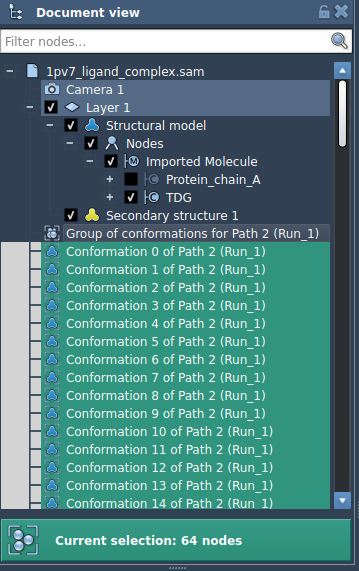If you’re working with molecular systems and want to explore how a system moves between two known structures—like a bound and unbound conformation—there’s a good chance you’ve considered using the Nudged Elastic Band (NEB) method. It’s a powerful tool to identify minimum energy paths. But what if all you have is a set of conformations? This is a common situation, and this post walks you through how to use the Parallel Nudged Elastic Band (P-NEB) extension in SAMSON to optimize a set of conformations into a meaningful transition path.

Why not always use a path?
If you already have a defined path—say, from a trajectory—that’s the most efficient way to use P-NEB. But in many workflows, especially when using structural interpolation or outputs from various sampling or docking processes, what you have is a set of discrete conformations. P-NEB in SAMSON lets you apply the NEB algorithm to this set and optimize the transition, even if the path itself isn’t initially present.
Step-by-step guide
Here’s how to get started with the P-NEB method in SAMSON when you’re working with conformations:
- Select your conformations: In the Document View, hold Ctrl and click to select each conformation you want to include in your transition analysis.
- Launch the P-NEB app: Navigate to
Home > Apps > All > P-NEB. You can also search for P-NEB via the Find Everything bar. - Configure your settings:
- Spring constant: 1.00
- Number of loops: 100
- Interaction model: Universal Force Field (UFF)
- Optimizer: FIRE
- Climbing image method: optional based on your needs
- Parallel execution: checked (for faster computation)
- Suffix name: NEB
- Run the calculation: Click Run in the P-NEB window. You’ll be prompted to use existing bonds; choose to use them and proceed.
Once the optimization completes, a new set of conformations will appear in the Document View. Each conformation is now part of a more physically meaningful path based on energy minimization principles.

Tips
- If your system is large, optimization from conformations may take some time. Be patient or consider simplifying the system.
- You can convert a set of conformations into a path before running P-NEB for improved performance. Right-click on the selected conformations in the Document View and choose Conformation > Create path from conformations.
Using conformations as input expands the scenarios where NEB can be useful. Whether you’re working with frames from a docking study or outputs from a sampling algorithm, the Parallel NEB extension in SAMSON allows refinement of your transition path in a physically consistent way.
Learn more in the full documentation: Optimize transition paths with the Parallel Nudged Elastic Band method.
SAMSON and all SAMSON Extensions are free for non-commercial use. You can download SAMSON at https://www.samson-connect.net.





